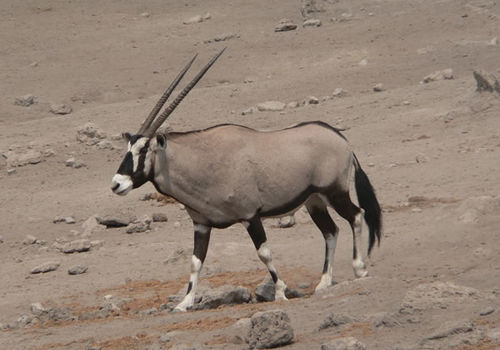
Gemsbok
Oryx gazellaGemsbok
Introduction: The oryx (Oryx gazella) is often known by its Afrikaans name - gemsbok, of which the origins are unknown. They are found all over Namibia and can tolerate arid areas which are uninhabitable to most other antelope, hence its status as Namibia's National animal. It obtains enough drinking water from food to survive and therefore does not need to drink. Gemsbok can tolerate extreme heat and to conserve water can allow its body temperature to rise to levels that would kill most animals, by cooling the blood going to the brain. Herds number anywhere between 5 and 40 animals, but aggregations of several hundred can occur.
Female herds include non-territorial bulls who will move between the territories of dominant bulls in search of food. To avoid conflict, non-territorial bulls are submissive towards territorial bulls. Fights between males are often fatal, one or both can receive severe stab wounds. When cornered by a predator, oryx will use their horns rigorously to defend themselves and attackers display extreme caution before advancing. The behaviour of this species is geared to energy and water conservation. In the heat of the day they will rest in the shade of trees. Where shade is not available they will orientate themselves to present as little as possible of their body surface to the sun.
Distribution: The sight of gemsbok in the dunes at Sossusvlei, with the rising sun as a backdrop, is not uncommon. It leaves an endearing memory. They are so common throughout Namibia that you are likely to see them next to the road throughout the entire country.
Diet: Gemsbok mostly feed on nutritious leaves, grasses and herbs. During the dry season they feed on flowers and will also browse for food.
Colouring: A large mainly grey-coloured antelope, with striking black and white markings on the face and legs, black side stripes on the flanks and a long black tail.
Breeding: Gemsbok are non-seasonal breeders. Only one calf is born after a gestation period of approximately 9 months, at any time of the year.
Size: Bulls measure 1.2m at the shoulders and attain a mass of 240kg. Both bulls and cows have horns, shorter and stockier on the male.
Klein Windhoek

